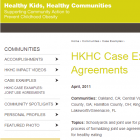Physical activity rates among children have declined over the past two decades, which is a concerning trend carrying multiple implications. Regular physical activity is crucial for youth development and leads to improved bone health, weight status, cardiorespiratory and muscular fitness, cognition, and reduced risk of anxiety and depression (U.S. DHHS, 2018). Yet, less than one-quarter (24 percent) of children 6-17 years of age do not engage in at least 60 minutes of daily physical activity as recommended in the Physical Activity Guidelines for Americans (U.S. DHHS, 2018; U.S. Report Card Research Advisory Committee, 2022). Youth of color, youth with disabilities, girls, and adolescent-age youth are even less likely to attain recommended physical activity levels. (U.S. Report Card Research Advisory Committee, 2022). In particular, physical activity rates remain higher for boys than girls, and higher for White students than for African-American and Hispanic students (U.S. DHHS, 2020).
Activity levels for many children have declined, due in part to a built environment that is unsafe for walking and bicycling, reduced physical education in school, and increased popularity of sedentary leisure-time activities. Safe Routes to School can create environmental, policy, and behavioral changes that increase physical activity and promote the health of both children and adults. Articles summarized in this section address the overall health benefits of physical activity, specifically walking to and from school, as well as the impact that increased physical activity opportunities have on health trends in the U.S. There is also a growing body of research included here to support the improved social and emotional health implications Safe Routes to School and active transportation on youth development.
Research Highlights:
- Children who walk to school get three times as much moderate to vigorous physical activity during their walk to school than during recess (Cooper et al., 2010). Children walk more when they live on more walkable routes with more open green space and less exposure to road traffic (Gallimore et al., 2011; Rahman, et al., 2011; Lamber et al., 2009).
- Implementation of Safe Routes to School initiatives like Walking School Buses have demonstrated improved rates of walking to school, increased daily moderate-to-vigorous physical activity, and support healthy weight (Quarles, 2012; Mendoza et al., 2011; Mori et al., 2012; Kong et al., 2010).
- Research demonstrates that children who walk or bicycle to school have higher daily levels of physical activity and better cardiovascular fitness than do children who do not actively commute to school (Mendoza et al., 2011; Davison, et al., 2008; Østergaard et al., 2012).
- One study suggests that a 5% increase in neighborhood walkability is associated with 32.1% more minutes devoted to physically active travel and about one-quarter point lower body mass index (0.228) (Frank, et al., 2006).
- Living in a walkable community has been associated with increased prevalence of healthy weight in adolescents (Slater et al., 2013).
- Perceptions of safety and attractiveness impact a neighborhood’s walkability (Project for Public Space, 2016; Ussery et al., 2017).
- There are gender, racial, and class disparities in how much people walk. Compared to affluent and primarily White neighborhoods, low-income neighborhoods and communities of color are perceived as less attractive and safe because of crime (Ussery et al., 2017).
- Investing in bike lanes is an investment in public health. People bike more when the built environment supports bicycling by including bike lanes, bike racks, and traffic calming (Dill et al., 2013; Hipp et al., 2013; Winters et al., 2016).
- In addition to more bike infrastructure and road engineering improvements to make bicycling safer, bicycle education is important (Pion et al., 2016).
- US metro areas with greater multi-modal transportation options (i.e., walking, bicycling, public transit) have better public health outcomes. People make healthier lifestyle choices, have more quality leisure time, exercise more, and live longer (Meehan et al., 2017; Frederick et al., 2017).
- Students can build stronger friendships and relationships through walking and biking together. Based on a CDC evaluation of 145 informants from 184 walking school bus programs from 2017 to 2018, every additional walking school bus trip per week was related to a 21 percent increase in the odds of experiencing less bullying (Carlson et al., 2020).

